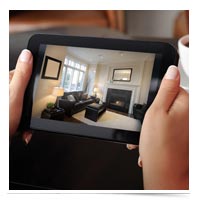First impressions are made at the front door
Home's entrance is seldom high on remodeling priorities
By Arrol Gellner
January 11, 2013
Have you ever been to a house where you had to skirt the gas meter or sidle around garbage cans to get to the front door? Or one where there was such a bewildering array of doors, you weren't sure which one to knock at?
The front entrance is seldom high on people's remodeling priorities. Yet, just like that old saw about first impressions, it's your home's entrance that people notice first. It's practically impossible to rectify a bad impression made at the front door.
Tract-home builders have known this for years; even in the cheapest house, they'll never cut corners on the front door. They know that a strong impression of quality here subtly colors a visitor's perception of the whole house.
For much of architectural history, front entrances have been a focal point of a home's design. In colonial New England, for example, the front door was often flanked by sidelights and topped by a pediment, setting it apart from an otherwise austere facade.
The entrance should also be clearly apparent from the street. That doesn't mean it has to be glaringly exposed to view -- just that its location should be easily deduced by an unfamiliar passerby. Architects call this principle "demarcation."
There are lots of subtle ways to demarcate a front entrance. The most common is to surround the door with an architectural form such as a pediment or other type of trim. Another traditional strategy places the door in a recess, on a projection, or under a roofed porch. You can find a well-known example of the latter on the back of a $20 bill.
Here are some thoughts for planning your own grand entrance:
The front entrance is seldom high on people's remodeling priorities. Yet, just like that old saw about first impressions, it's your home's entrance that people notice first. It's practically impossible to rectify a bad impression made at the front door.
Tract-home builders have known this for years; even in the cheapest house, they'll never cut corners on the front door. They know that a strong impression of quality here subtly colors a visitor's perception of the whole house.
For much of architectural history, front entrances have been a focal point of a home's design. In colonial New England, for example, the front door was often flanked by sidelights and topped by a pediment, setting it apart from an otherwise austere facade.
The entrance should also be clearly apparent from the street. That doesn't mean it has to be glaringly exposed to view -- just that its location should be easily deduced by an unfamiliar passerby. Architects call this principle "demarcation."
There are lots of subtle ways to demarcate a front entrance. The most common is to surround the door with an architectural form such as a pediment or other type of trim. Another traditional strategy places the door in a recess, on a projection, or under a roofed porch. You can find a well-known example of the latter on the back of a $20 bill.
Here are some thoughts for planning your own grand entrance:
- Don't place an unsheltered entrance door flush with the front wall of the house; it'll create an unwelcoming "side door" or trailer-door effect.
- Don't bring the path to the front door past utilities such as gas or electric meters, or past unsightly storage areas for trash or the like. Keep these kinds of features out of the visitor's line of sight.
- Don't force visitors to walk on a driveway to get to your front door. Provide a separate walking path, or at least set aside a portion of the driveway paving using a different color or texture so it's clearly meant just for those on foot.
- If you plan to provide a covered entrance porch, make it at least 6 feet wide -- enough for a person to stretch out both arms without touching either wall. Anything less will feel cramped and uncomfortable. Also, make the porch at least 4 feet deep (6 feet is better), or it'll feel cramped when more than one person is waiting outside the front door. A cheaper alternative to building a projecting porch is simply to recess the front door. Again, make the recess at least 6 feet wide, and not less than 2 feet deep.
- Lastly, if your house has several doors facing the street, make sure your front approach aims your visitors toward the main entrance. Your front door may seem obvious to you, but, hey, you live there.





 Long gone are the days of a bulky surveillance camera, expensive installation, and bulky home recording setup. With wireless technology and speedy home bandwidth the norm in most homes, you can have a video home security system up and running in no time.
Long gone are the days of a bulky surveillance camera, expensive installation, and bulky home recording setup. With wireless technology and speedy home bandwidth the norm in most homes, you can have a video home security system up and running in no time.